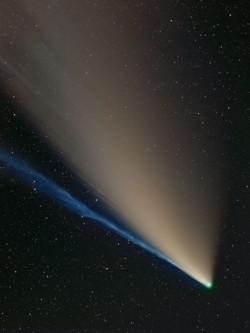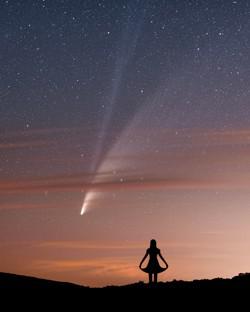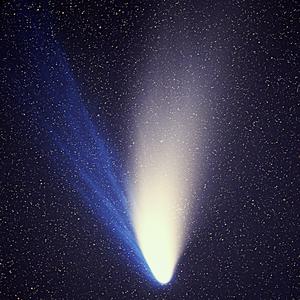Glossarbegriffe: Kometenschweif
Description: Wenn sich ein Komet in der Nähe der Sonne befindet, erhitzt die Sonnenstrahlung die Oberfläche des Kometen. Das Eis auf der Oberfläche wird zu Gas (es "sublimiert") und nimmt dabei winzige Gesteins- und Staubteilchen mit. Die daraus resultierende Mischung bildet eine Wolke um den Kometenkern, die Koma genannt wird.
Üblicherweise hat ein Komet zwei Schweife: Die ausgestoßenen Staubteilchen bilden den Staubschweif des Kometen, der eine charakteristisch gekrümmte Form hat. Er besteht aus Staubteilchen, die von der Oberfläche freigesetzt werden und dem Kometen auf seiner Umlaufbahn um die Sonne folgen. Staubschweife können Millionen von Kilometern oder mehr lang sein. Sie reflektieren das Sonnenlicht. Unter den richtigen Bedingungen ist es größtenteils ihre weißliche, verschwommene Form, die man beobachten kann, wenn ein Komet mit bloßem Auge sichtbar ist. Ein erheblicher Teil des Gases wird vom Sonnenwind - den elektrisch geladenen Teilchen, die von der Sonne ausgestoßen werden - weggeblasen und ionisiert. Diese Ionen bilden den Ionenschweif des Kometen, der normalerweise eine bläuliche Farbe hat. Der Ionenschweif zeigt immer geradeaus von der Sonne weg. Wenn sich der Komet selbst von der Sonne wegbewegt, eilt der Ionenschweif dem Kometen voraus.
Zugehörige Glossarbegriffe:
See this term in other languages
Term and definition status: The original definition of this term in English have been approved by a research astronomer and a teacher The translation of this term and its definition is still awaiting approval
The OAE Multilingual Glossary is a project of the IAU Office of Astronomy for Education (OAE) in collaboration with the IAU Office of Astronomy Outreach (OAO). The terms and definitions were chosen, written and reviewed by a collective effort from the OAE, the OAE Centers and Nodes, the OAE National Astronomy Education Coordinators (NAECs) and other volunteers. You can find a full list of credits here. All glossary terms and their definitions are released under a Creative Commons CC BY-4.0 license and should be credited to "IAU OAE".
If you notice a factual or translation error in this glossary term or definition then please get in touch.
Zugehörige Medien
Comet C/2020F3 (Neowise) with separate dust and ion gas tails and a green glowing coma, by Dietmar Gutermuth, Germany
Bildnachweis: Dietmar Gutermuth/IAU OAE
License: CC-BY-4.0 Creative Commons Namensnennung 4.0 International (CC BY 4.0) icons
Hello Comet, shall we dance?, by Robert Barsa, Slovakia
Bildnachweis: Robert Barsa/IAU OAE
License: CC-BY-4.0 Creative Commons Namensnennung 4.0 International (CC BY 4.0) icons
Comet Hale-Bopp
Bildnachweis: E. Kolmhofer, H. Raab; Johannes-Kepler-Observatory, Linz, Austria credit link
License: CC-BY-SA-3.0 Creative Commons Namensnennung - Weitergabe unter gleichen Bedingungen 3.0 Unported icons











